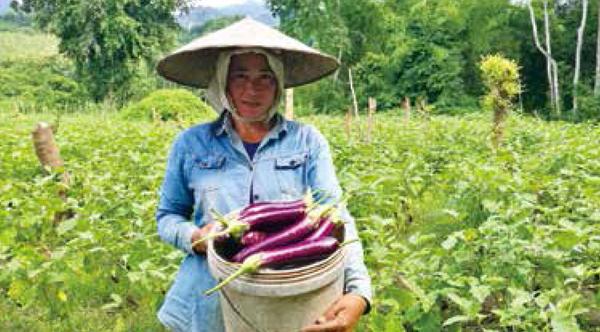减贫合作:中老关系里的一抹暖色
黄昀昀


2021年4月6日,中国国务院发布了《人类减贫的中国实践》白皮书,不仅向世界展示了中国减贫取得的伟大成效,也集中阐述了中国在国际减贫事业上的贡献,其中就包括在老挝、柬埔寨、缅甸3国乡村基层社区实施“东亚减贫示范合作技术援助项目”。广西外资扶贫项目管理中心是3国里,中老减贫合作示范项目(以下简称中老减贫项目)的实施单位,在老挝万象市桑通县版索村和琅勃拉邦市象龙村开展了为期3年的减贫工作。
中老减贫项目为村民生活带来了什么变化?中方又是如何推动村民脱离贫困队伍的?就这些问题,广西外资扶贫项目管理中心副主任韦克在接受本刊记者专访时,给出了答案。
中国团队到来,示范村旧貌换新颜
从2017年到2020年,时光在版索村和象龙村两个减贫示范村里,镌刻下了发展的印记——平整的沥青道路、牢固的钢桁桥、全新的校舍和村级活动中心等基础设施,皆是中老减贫项目的颗颗珍贵果实。
在广西外资扶贫项目管理中心提供的相片里,一名小伙的头发和背上沾满了泥土路扬起的黄色尘土。过去,版索村村民对此习以为常。“落雨一身泥,天晴一身灰。” 版索村副村长坎占曾这样总结泥土路给村民们带来的困扰。而如今,共计4.16公里的沥青路取代了原有土路,它们似不断延展的枝叶,为曾经黄土飞扬的两座村庄带去了清新的绿意与发展的生机。
据韦克回忆,在交通问题上,除了道路,陈旧的桥梁也一度令人头疼。此前,版索村的木质旧桥横跨在河流之上,密密麻麻的木桩立于河床,支撑着桥面。这是一些孩子上学的必经之路,如今,它被一座中国援建的钢桁桥替代。现代化的桥墩、桁架和路面处处体现着坚固牢靠。这座桥建成以后,不仅便利了村民之间的往来,为生产区提供物资的车辆也能直接穿桥而过,告别了蹚水运输的时代。“之前,我们连做梦都不敢想有这样一天。” 坎占的感叹让韦克印象深刻。
电力是人们生活的刚需,此前村民们的日常用电虽已得到满足,但村内没有夜间照明。中老减贫项目启动后,一盏盏太阳能路灯在村里立了起来,不仅优化了照明条件,还“点亮”了村里的夜生活。韦克介绍,现在各种便利店、小吃店开始在夜间营业,村民会聚集在路灯下闲聊、孩子们在路上玩耍,整个村子比以前热闹许多。
总体来说,中老减贫项目团队在改善基础设施方面下了大功夫。除了上述项目,团队还建成了生产区桥涵1座、村级活动中心2座、村卫生室2个、学校宿舍4座、操场2个、厕所2个、织布展示厅2个等,实实在在地改善了村民们的生活环境。
老挝农林部副部长坎本纳·塞亚农就曾对项目表示肯定:中国援老挝减贫示范合作項目由两国政府共同实施,给老挝带来了一种全新的减贫模式。我们要将其作为示范工程向全国推广,使更多老挝民众受益。
当“以人为本”融入减贫工作
“人”是社会的核心要素。在减贫合作中,中方始终贯彻“以人为本”的减贫理念,这不仅体现在建设项目的选择上,还体现在项目实施的过程中。
韦克表示,“缺什么补什么”是减贫团队规划项目的原则。而“缺什么”,由村民们说了算。在进行项目可行性调研时,团队组织村民用投票选出了他们认为最迫切的需求——解决饮用水入户难题。“象龙村有172户814人,世世代代生活用水都靠收集雨水,或从流经村旁的南康河挑水饮用。南康河河床深,旱季提水困难,并且经当地部门检测,水质达不到饮用水标准。”韦克说,这是该示范村用水的痛点。
但投票过程中,村内道路、活动中心、卫生室、太阳能路灯等项目的得票率也很高,如何在援助资金有限的情况下,尽可能多地兼顾更多需求呢?减贫团队决定想办法压缩引水入户工程的建设成本。
据韦克介绍,后来在当地政府的帮助下,减贫团队以自愿为原则,组织当地群众投工投劳,从5公里外为象龙村引来了符合当地饮用标准的山泉水,并将水管接到了每家每户。“他们参与建设的热情高涨,因为大家都明白这是在为自己劳动。”韦克说,通过村民齐心协力地努力,饮水入户工程造价从最初预算的200万元人民币降低到67万元人民币。
水管不仅为村民输送来饮用水,还将老挝重大传统节日——泼水节带到了村民家门口。韦克说:“过去村内没有干净的水源,村民要前往琅勃拉邦市过泼水节。而现在,村民在家门口就能实现泼水祈福的愿望。”
而对于两个示范村的农业发展状况,韦克称:“还停留在非常初级的阶段。”他介绍,老挝农业生产结构单一,缺乏技术与资金支持,没有灌溉设备或设备简陋,收成主要靠“天意”。
他说,为解决这一问题,改善村里的基础设施后,中方援助着力推进农户生计项目发展,在现有产业结构基础上,增加对中低收入农户的产业投入。目前,象龙村已按计划发展织布、养牛、养鸡、大棚蔬菜、露天蔬菜种植等项目。以蔬菜种植示范户为例,每户每年可增收1万元人民币以上。
期待在减贫路上再次相遇
3年间,中老减贫项目借鉴中国以政府为主导、群众参与为基础的“整村推进”减贫经验,对示范村开展了5个方面的帮扶,包括基础设施建设、公共服务、农户生计改善、能力建设和技术援助等。在同一标准下,示范村贫困发生率产生了显著的变化:从最初的52%下降到项目终期评估时的25%。
2020年11月,中国国务院总理李克强在第23次东盟与中日韩(10+3)领导人会议上提出中方愿实施“东亚减贫合作倡议二期”项目,实现地区协调发展。此前,中方团队在减贫合作中融入许多广西扶贫经验,但项目基础条件薄弱,项目期仅有3年,加上2020年受到新冠肺炎疫情冲击等客观原因,部分项目设计和理念的减贫效果还需要一定时间来展现。因此,韦克表示:“我们也希望并积极争取参与二期项目建设,在中老减贫示范合作项目经验的基础上,为东盟国家减贫发展作出更多贡献。”
韦克认为,广西还有“升级”版的扶贫经验可以帮助老挝贫困农村发展添后劲。在农村发展方面,他提议进一步引入中老企业、高校、社会团体等参与项目活动,形成大扶贫格局;进一步壮大发展村集体经济,为乡村基础设施和公共服务设施升级提供支撑,促进乡村发展提质增效。在农业发展方面,他提出可提升农民合作组织专业化程度,提高统一标准,优化品种、提升品质、打造品牌,提高农产品附加值;还可适当配套发展农产品加工业,延长产业链,增加就业机会。
授人以魚只救一时之急,授人以渔则可解一生之需。随着中老命运共同体建设的不断推进,我们相信,中老两国间的减贫合作故事一定还会延续。
On April 6, 2021, the State Council of China released the white paper Chinas Practice in Human Poverty Reduction, which not only shows the countrys great achievements made in poverty reduction to the world, but also elaborates on its contribution to global poverty reduction such as the “East Asia Poverty Reduction Demonstration Cooperation Technical Assistance Projects” program implemented in rural communities in Laos, Cambodia, and Myanmar. Among the three countries, Guangxi Foreign Capital Poverty Reduction Project Management Center is the unit responsible for the poverty reduction in Laos. It has carried out poverty reduction for three years in Ban Xor Village in Sangthong of Lao capital Vientiane and Xienglom Village in Luang Prabang.
What changes has the poverty reduction project brought to villagers lives? How does China lift local people out of poverty? Wei Ke, Deputy Director of Guangxi Foreign Capital Poverty Reduction Project Management Center, answered these questions in an interview with the reporter from China-ASEAN Panorama.
Chinese team brings new look to demonstration village
From 2017 to 2020, great changes have taken place in the two poverty reduction demonstration villages of Ban Xor and Xienglom — flat asphalt roads, solid steel truss bridges, and brand-new infrastructures like school buildings and activity centers, all of which epitomize the great achievements made in poverty reduction cooperation between China and Laos.
In the photo provided by Guangxi Foreign Capital Poverty Reduction Project Management Center, a young mans hair and back are covered with yellow dust raised from dirt roads. In the past, villagers in Ban Xor got used to it. “In rainy days we are troubled by mud, while in sunny days, by dust.” Kham Zham, Deputy Head of the village once summed up the troubles brought by the dirt road to the villagers. Now, a total of 4.16 kilometers of asphalt roads have replaced the original ones, bringing vitality to the two villages.
According to Wei Ke, in addition to the roads, old bridges were once a headache too. In the past, the old wooden bridge in Ban Xor was supported by dense wooden piles standing on the river bed, serving as the only way for children to go to school. Now, it has been replaced by a steel truss bridge with modern piers, trusses, and roads, which are solid and reliable. After completing, the bridge not only facilitates the communication between villagers, but also makes sure vehicles can directly pass through, ending the era of wading through the water. “We didnt even dream of such a day.” Kham Zhams words impressed Wei Ke.
Electricity is the rigid demand of people. Although villagers daily electricity consumption has been met before, there is no illumination at night in the village. Since the implementation of the China-Laos Poverty Reduction Project, solar lamps have been seen on the streets in the village, which not only optimized the illumination conditions, but also enriched the villagers night lives. According to Wei Ke, now, many convenience stores and snack bars are open at night. Villagers gather to chat and children play under the street lamps. The whole village is more bustling than before.
In a word, people engaged in China-Laos Poverty Reduction Project have made great efforts in improving infrastructure. Besides the improvemnt in infrastructure, they have also built a variety of public facilities, effectively improving the living environment of the villagers.
Campana Seyanon, Deputy Minister of Agriculture and Forestry of Laos, showed a positive attitude towards the project: China-aided Laos Poverty Reduction Demonstration Cooperation Project is jointly implemented by the two governments. It has brought Laos a new model in poverty reduction. We will promote it to the whole country to benefit more people.
Integrating people-oriented philosophy into poverty reduction
People function as the core element of society. In poverty reduction cooperation, China has always upheld the people-oriented philosophy, reflected not only in the selection of projects, but also in the process of implementation.
According to Wei Ke, poverty reduction is based on the principle of supplying the shortage. Villagers have the final say in this respect. In the process of investigating the feasibility of the project, the poverty reduction team organized villagers to vote for their most urgent needs, which appeared to be household water shortage. “There are 814 people in 169 households in Xienglom Village. For generations, people rely on collecting rainwater or carrying water from the Nam Khan river to meet their needs in daily life. However, the riverbed is deep and it is not easy to collect water in the dry season. Besides, the water quality failed the drinking water test by local departments. Villagers have been troubled by this problem for a long time,” said Wei Ke.
Besides household water shortage, the voting rate of constructing roads, activity centers, clinics, solar street lamps is also very high. Since the funds for assistance are limited, how can we meet their needs as much as possible? The poverty reduction team tried to find ways to reduce the cost of the water diversion project.
According to Wei Ke, with the help of the local government, the poverty reduction team organized local people to work voluntarily. From five kilometers away, villagers found mountain spring water meeting the safety standards. The water pipes were connected to every household. “They are enthusiastic about participating in the construction. Everyone knows that they are working for themselves. Through the concerted efforts, the cost of the water diversion project has been reduced from RMB 2 million yuan to RMB 670,000 yuan,” said Wei Ke.
The water pipes bring not only drinking water to the villagers but also the Water Splashing Festival, a major traditional festival in Laos, to their homes. “In the past, there was no clean water source in the village, so the villagers had to go to Luang Prabang for the Water Splashing Festival. Now, they can splash water and pray at home,” said Wei Ke.
As for the agricultural development in the two demonstration villages, Wei Ke said:“ It is still in a very primary stage.” He pointed out that Laos has a single agricultural structure that lacks technical and financial support. There is no irrigation equipment or the equipment is primitive. The harvest largely depends on “providence”.
According to Wei Ke, to solve this problem, after improving the infrastructure, the assistance would turn to promote peoples livelihood. Based on the existing industrial structure, the investment would be increased to aid low- and middle-income farmers. At present, Xienglom Village has developed weaving, cattle and chicken raising, greenhouse and open-air vegetable planting, and other projects as planned. Take the vegetable planting as an example, each household can increase income by more than RMB 10,000 yuan per year.
More contribution to ASEAN countries in poverty reduction
In the past three years, China-Laos Poverty Reduction Project drew lessons from Chinas “whole-village pushing forward in poverty alleviation” which features government-led and mass participation, providing assistance to the demonstration villages in infrastructure construction, public services, peoples livelihood, and agricultural management ability, and technical support. Under the same standard, the poverty headcount ratio in the demonstration villages has reduced significantly from 52% to 25%.
In November 2020, at the 23rd ASEAN Plus Three (APT) Summit, Chinese Premier Li Keqiang proposed that China is willing to implement phase II of the Cooperation Initiative on Poverty Alleviation in East Asia, so as to achieve coordinated regional development. The poverty reduction team had integrated a lot of experience gained in Guangxi into the cooperation with Laos before. However, because of the poor conditions in targeted villages and limited time, plus the outbreak of the pandemic, some designs and concepts failed to work at full capacity in the two demonstration villages. In this regard, Wei Ke said:“ We hope to implement phase II of the project and make more contributions to the poverty reduction in ASEAN countries based on the experience of China-Laos Poverty Reduction Project.”
Wei Ke believes that Guangxi has better poverty alleviation experience to help Laos in revitalizing poor rural areas. In rural development, he proposed to let enterprises, universities, and social organizations in Laos participate in the project, so as to achieve broad participation in poverty alleviation. In agricultural development, he proposed to improve the specialization of cooperative organizations, optimize crop varieties and quality, and establish brand awareness, to add value to agricultural products. Besides, he suggested to develop processing industries to extend industrial chains, increasing employment opportunities. In developing the rural collective economy, he proposed to promote the quality and efficiency of rural development based on the upgraded rural infrastructure and public facilities.
Give a man a fish, and you feed him for a day; teach a man to fish, and you feed him for a lifetime. With the continuous advancement of the China-Laos community with a shared future, we believe that more poverty reduction cooperation between China and Laos is yet to come.

